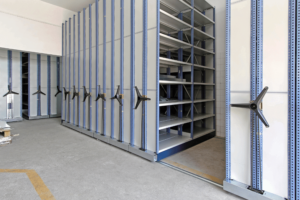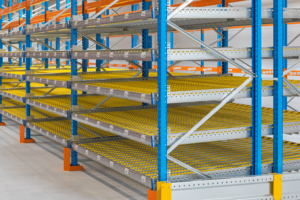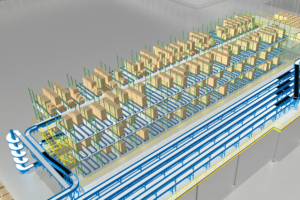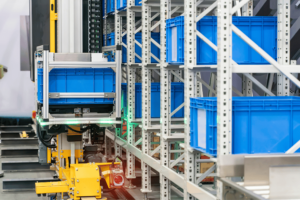Imagine finding yourself in the heart of a warehouse surrounded by a seamless operation. Forklifts swiftly navigate from storage to dispatch, handling pallets effortlessly. This vision can be a reality all thanks to the clever application of smart racking solutions.
As warehouses and distribution centers evolve, more and more of these facilities partner with top-notch solutions providers to stay ahead of the curve.
In this article, you will discover:
– How to design your warehouse for maximum efficiency
– Selecting the right pallet rack for your needs
– Safety and Stability in Warehouse Racking systems
– And More!
Let’s dive in!
Understanding the Basics of Warehouse Racking
Warehouse racking is not just about stacking things, rather it is a smart way to use space effectively. Warehouse racking helps organize items making it easier to find what you need and reduce clutter.
Designing Your Warehouse for Maximum Efficiency

When planning your warehouse racking we are not just playing a game of storage Tetris; we’re working to make your business run more efficiently giving you more room to work and breathe.
Planning Your Warehouse Layout for Optimal Flow
A trend towards organized and intelligently designed warehouses is changing the industry from messy to efficient. Every part of your space should be carefully planned to support your workflow. It is like setting up dominos: each section should connect smoothly to the next without any jams or dead ends.
Optimizing Storage Capacity with High-Density Solutions

Does your warehouse always seem short on space? A High-density storage system may be the answer for you. These storage units are designed to make the most of your space without sacrificing accessibility.
Advantages of High-Density Storage Systems
- More storage: These systems pack items tightly, giving you more storage without extra space.
- Easy access: Contrary to what you might think, you shouldn’t need to dig for your stuff. High-density systems allow quick access, even in tight spaces.
- Better inventory control: Easier access and less mess will result in fewer items lost and a happier stock manager.
Implementing High-Density Warehouse Solutions
Ready to make your warehouse more efficient? Here’s how to get started:
-
- Analyze: Look closely at your items—size, volume, and movement.
- Pick wisely: Choose from options like mobile shelving or tall pallet racks based on your inventory needs.
- Tech it up: If you have the budget, consider automated systems to make high-density storage even more efficient.
Key Takeaway:
High-density storage can greatly improve how you use warehouse space, but careful planning is key to ensuring it works well for you.
Enhancing Warehouse Operations with Flow Carton Racking

Benefits of Flow Racking in Warehouse Operations
Imagine a system where products come to you instead of having to reach for them. Flow racking makes this possible by using gravity-powered rollers to move items closer to the aisle once the item in front has been picked. This system reduces the time spent handling products resulting in the staff focusing on other tasks and experiencing less physical strain.
How Carton Flow Systems Improve Efficiency
Carton flow systems are perfect for boosting efficiency in warehouses. They make picking easier by having products flow toward pickers at comfortable heights.
Advantages:
- Faster Picking: Items move smoothly towards workers, so they can grab what they need quickly and without extra effort.
- Better Space Utilization: These systems make the most of both vertical and horizontal space, revealing extra room you might not have noticed.
- Ease of Access: No more searching through piles or reaching up high—everything is within easy reach.
Key Takeaway:
Slow order fulfillment can strangle a business, but carton flow systems cut through the bottlenecks, streamlining operations and unleashing a tidal wave of efficiency that resonates throughout the organization.
Workflow automation has a secondary benefit – it significantly cuts down on inventory damage caused by human error. This leads to fewer accidents and profit loss.
For more details on how to set up these systems in your warehouse, talk to an expert to find the best solution for your needs. If you are in Wisconsin or the Upper Peninsula of Michigan, Conger Industries has locations in Green Bay, Neenah, Wausau, Richfield, and Madison and is ready to help set up the perfect racking system for you.
Customized Industrial Shelving and Pallet Shelf Units

Tailoring Shelving Units to Meet Specific Needs
In your storage system, every item needs its perfect spot. When that spot doesn’t exist, we create it with custom industrial shelving and pallet racks. These shelves are built to handle heavy loads and last a long time.
Maximizing Storage Efficiency:
Custom shelving solutions make better use of your warehouse space compared to standard racks. They can be adjusted in height and width to fit your needs and work well with your existing storage equipment.
Enhancing Inventory Accessibility & Management:
A tailored storage system enhances efficiency by saving time and minimizing errors in order fulfillment.
Customizing shelf sizes and arrangements according to product dimensions and demand ensures easy access to high-demand items, while the less accessed stock is stored compactly in higher or more efficient spaces.
Benefits:
- Better visibility of stored items
- Easier stock retrieval
- More accurate inventory counts
Durability Tailored To Your Needs:
Custom shelving can be designed to handle different load capacities and environmental conditions. Whether you need rust-resistant finishes for food storage or strong steel for heavy items, specifying the racking materials and tailoring them to your specific environmental conditions ensures your racks perform well and last longer.
Key Takeaway:
Custom shelving units are essential for optimizing storage efficiency, improving inventory management, and ensuring durability. By tailoring shelves to fit your specific needs, you make better use of space, enhance accessibility, and improve the longevity of your storage system.
Strategies for Managing SKU Stock Count and Volume Case Picking

Optimizing SKU Organization with Smart Racking Solutions
In the world of material handling, managing SKUs (Stock Keeping Units) effectively is crucial. The adoption of advanced racking systems to systematically scan and organize items based on their movement frequency—high, medium, and low—can significantly enhance the efficiency of the picking process.
This method boosts efficiency and reduces worker strain by cutting down unnecessary movement. Flexible racking options, like selective pallet racks or mobile shelving, make it easy to adapt to changing inventory needs, further enhancing organization and efficiency.
Adopting Advanced Warehouse Management Systems (WMS)
Using advanced Warehouse Management Systems (WMS) is essential for handling changing fluctuations and making the volume case-picking process smoother.
A strong WMS improves real-time inventory visibility, allowing for accurate stock adjustments and reducing errors.
Adding technologies like barcode scanning or RFID tagging to WMS helps quickly identify and track items in the warehouse. This speeds up order fulfillment, cuts down on manual entry mistakes, and greatly increases productivity.
Implementing Efficient Picking Strategies
- Zoning: Divide your warehouse into specific zones based on product type or picking frequency to cut down on travel time during order collection.
- Batch Picking: Group similar orders together so pickers can collect multiple orders in one trip, reducing the number of trips across the warehouse.
- Pick-to-Light Systems: Use light-directed picking technologies to guide employees quickly to item locations, improving speed and accuracy in fulfilling orders.
Implementing these methods requires upfront costs for infrastructure and training, but they offer long-term benefits like higher productivity, less physical stress on employees, and faster deliveries, which improve customer service. These strategies ultimately lead to better financial performance for companies managing modern supply chains.
Key Takeaway:
Optimizing SKU organization with advanced racking, robust WMS, and efficient picking can boost warehouse efficiency. These methods reduce unnecessary movement, improve inventory tracking, speed up order fulfillment, and increase productivity, despite their high initial investments in infrastructure and training.
Achieving an Efficient FIFO Inventory Flow

The First-In-First-Out (FIFO) method is a superior strategy for managing stock efficiently. It helps reduce waste and maintain product quality.
Understanding the Basics of FIFO
The FIFO inventory management technique is simple: the first goods stored are the first ones used. This method is especially useful for perishable goods or products with expiration dates, as it minimizes spoilage and keeps items fresh for customers.
Key Elements of FIFO:
- FIFO Racks: These shelves are specifically designed for FIFO inventory management, ensuring that the first item stored is always the first one out.
- Pallet Flow Systems: This system moves warehouse pallets smoothly down a gentle slope toward the pick-up area, enhancing operations.
- Smart Software: This software tracks each item’s journey through the warehouse from entry to exit, eliminating uncertainty about location or timing.
Incorporating these racking solutions streamlines warehouse operations by automating much of the manual processes involved in inventory management.
Automated Storage and Retrieval Systems (AS/RS) further improve efficiency through precision-engineered software that controls movement within these structures. This allows for effortless real-time tracking and significantly reduces human error.
Leveraging Automated Storage Systems
Understanding Automated Storage Solutions
Automated storage systems use technology to organize, retrieve, and store items with minimal human input. With specialized software, these systems offer precise inventory control and faster operational responses.
The Benefits of Automation in Storage Management
- Increased Efficiency: Automation reduces the time needed for retrieving or storing items, allowing employees to focus on other tasks.
- Better Space Utilization: Automated systems make the most of vertical space and can be customized to fit specific warehouse designs, efficiently using available space.
- Error Reduction: Automated systems reduce errors in inventory management by ensuring precise control over item movements.
- Safety Improvements: By reducing the need for physical handling, these systems lower the risk of workplace injuries from lifting heavy objects or working in tight spaces.
To maximize the benefits of an automated storage system, businesses must assess their needs, including the type and quantity of items to be stored, how often they need access and budget constraints.
Key Takeaway:
When properly implemented, automated storage solutions can significantly boost productivity, optimize space usage, and improve safety standards, positioning companies for success in a competitive environment.
How Pick Modules Streamline Order Fulfillment Processes

Making Storage and Order Picking Easier
Pick modules help businesses organize their inventory and speed up the order-picking process. These systems save space, reduce the time workers spend walking around, and make preparing orders faster.
Using Vertical Space Efficiently
One major benefit of pick modules is that they use the vertical space in a warehouse. Traditional storage leaves a lot of space unused, but pick modules stack items vertically. This helps businesses use space better, especially if they don’t have much room to expand.
- Zoned Picking: Divide the warehouse into different areas based on product type or how often items are picked to reduce how much workers need to walk.
- Bulk Restocking: Restock items during slower times directly above the picking bins using gravity flow racks.
- Cross-Docking: Move items directly from receiving to shipping without long-term storage when possible.
Key Takeaway:
Pick modules improve warehouse efficiency by utilizing vertical space, reducing walking time, and employing practices like zoned picking, bulk restocking, and cross-docking to speed up order preparation and enhance customer satisfaction.
Choosing the Right Pallet Rack for Your Needs

Finding Affordable Storage Solutions
To find the right racking system, you need to understand your storage needs. Knowing the type, size, and weight of the items you store helps you choose the right system. This ensures you use your warehouse space effectively.
Selective vs. Dynamic Racking Systems
- Selective Racking Systems: These are versatile and allow easy access to each pallet.
- Dynamic Racking Systems: These are better for businesses with high turnover or perishable goods. Systems like push-back and flow racks improve storage density and reduce picking times by automatically moving items closer to the picking aisle.
Although dynamic systems can be more expensive initially, they save money over time by making operations more efficient.
Using Technology for Smart Warehouse Management
Adding technology to warehouse operations makes using racking systems more effective. A Warehouse Management System (WMS) lets you track inventory levels in real time, making it easier to organize stock based on how often items are accessed or when they expire. This reduces unnecessary movement and saves time.
Maintaining Your Racking Systems

Regular maintenance and understanding OSHA standards help prevent accidents and extend the life of your storage equipment.
Routine Inspections:
Regular inspections help find and fix problems early, preventing costly repairs and downtime.
Preventive Maintenance:
Scheduled maintenance ensures all parts are in good condition. This includes tightening bolts, replacing damaged parts, and sticking to weight limits to avoid bigger problems later.
- Safety Compliance: Following OSHA guidelines keep workers safe.
- Critical Adjustments: Regular checks help use space and resources better.
- Economic Benefits: Regular maintenance reduces long-term costs and prevents expensive repairs or replacements.
Using Professional Expertise
Professionals can provide valuable insights and recommendations to keep your racking systems in top shape without disrupting daily activities.
Safety and Stability in Warehouse Racking Systems

Keeping Forklifts Stable in Narrow Aisles
Making sure forklifts are stable in narrow aisles is important to prevent accidents and ensure safe operations.
- Know Your Equipment: Use forklifts designed for narrow aisles.
- Aisle Width Matters: Ensure aisles are wide enough for your forklifts.
- Proper Training: Train drivers to handle tight turns safely.
- Maintenance: Regular check-ups prevent equipment failures.
Following OSHA guidelines and regular inspections help maintain a safe warehouse.
Conclusion

Understanding industrial racking solutions is important for improving space efficiency and productivity. Choosing the right system, from selective racks for easy access to pallet flow systems for FIFO strategies, helps manage inventory better and improve customer service. Smart racking decisions help businesses grow and succeed by making operations more efficient and effective.

